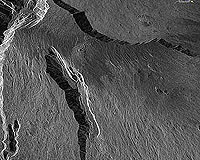 |
Guildford, UK (SPX) Jul 02, 2009 DMCii has announced the selection of 5 science projects that will receive free satellite imagery from the DMC satellite constellation. Satellite imaging is a powerful tool for monitoring land use. It offers a valuable "eye in space" for monitoring and recording environmental change on a global basis. The winning projects cover a wide range of important topics: from monitoring changes in the Greenland Ice Sheet and the UK wetlands and forests, to pioneering new techniques for integrating satellite Earth observations with computer models to improve measurements of how the Earth's vegetation 'breathes' carbon dioxide. DMCii Managing Director David Hodgson said "At a time of significant global change we are very pleased to be able to support the research community in increasing our understanding of our changing environment." In December 2008, scientists were invited to compete for the opportunity to use the DMC multi-spectral satellite image data in their research projects. Applications were judged on their contribution to international environmental research by a panel of scientists chaired by Professor Alan O'Neill from the UK's National Centre for Earth Observation (NCEO), Dr Arwyn Davies, Head of Earth Observation at the British National Space Centre (BSNC), Dr Paul Aplin (Chairman of RSPSoc and Associate Professor Nottingham University), Dr Steve Mackin, Chief Scientist DMCii and David Hodgson, Managing Director DMCii. The successful projects are: - Monitoring Dynamic Change in the Greenland Ice Sheet: A. Luckman (Swansea University). - Testing Data Assimilation Schemes: JJ Settle (University of Reading), P North (University of Swansea), T Quaife (University College London). - Assessing Seasonal Water and Restoration Status of Wetland Habitats: Dr G Smith (Specto Natura Ltd), Dr F Hughes and Dr P Stroh (Anglia Ruskin University), Dr P Aplin (University of Nottingham). - Validation of MODIS NPP (Net Primary Productivity) Product for Tropical Areas: Dr M Cutler (University of Dundee), Prof A Cracknell, Assoc Prof AL Ibrahim, Dr K Haron. - Monitoring of Vegetation Phenological Change and Health: Dr R Guisa (University of Surrey), Dr R Pitman (Centre for Forestry and Climate Change (FR)). The DMC constellation of five satellites provides a unique earth observation resource that enables daily revisit anywhere in the world. As the satellites and their respective owners (Algeria, China, Nigeria, Turkey, UK) cooperate together, the constellation can image a given geographical location frequently to identify changes or make the most of cloud-free periods. This unique combination makes the constellation highly effective for monitoring changes in land use. The free satellite data will be provided by next generation DMC satellite UK-DMC2 which is scheduled for launch next month, July 2009. The new satellite will enhance the DMC constellation's ability to gather higher spatial resolution imaging (22m versus the previous 32m DMC standard) and also increase the amount of imagery that can be stored and downloaded in any given time using new satellite technology. Spanish company, Deimos Imaging, that is also part of the DMC Consortium, is planning to offer a similar research opportunity for Spanish researchers. They intend to provide imagery for five Spanish science projects from their new Deimos-1 satellite which will be launched at the same time as UK-DMC2. Share This Article With Planet Earth
Related Links DMCii Earth Observation News - Suppiliers, Technology and Application
 TerraSAR-X Image Of The Month: Piton de la Fournaise
TerraSAR-X Image Of The Month: Piton de la FournaiseBonn, Germany (SPX) Jun 29, 2009 The image, taken by the German radar satellite TerraSAR-X, shows the volcano 'Piton de la Fournaise' (Furnace Peak) in the south of the island of La Reunion (Indian Ocean). This is the last active volcano on the island and is 2631 metres high. By means of very precise repeat-pass interferometric measurements, TerraSAR-X is able to detect even small movements of the Earth's surface, thus ... read more |
|
| The content herein, unless otherwise known to be public domain, are Copyright 1995-2009 - SpaceDaily. AFP and UPI Wire Stories are copyright Agence France-Presse and United Press International. ESA Portal Reports are copyright European Space Agency. All NASA sourced material is public domain. Additional copyrights may apply in whole or part to other bona fide parties. Advertising does not imply endorsement,agreement or approval of any opinions, statements or information provided by SpaceDaily on any Web page published or hosted by SpaceDaily. Privacy Statement |